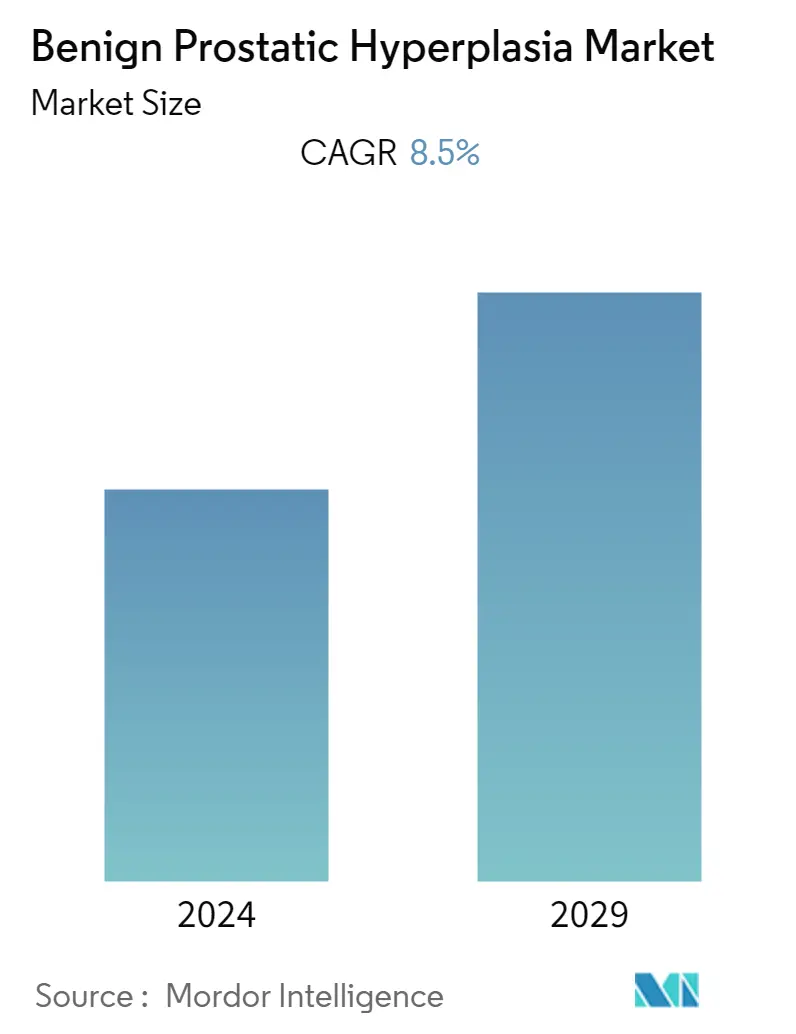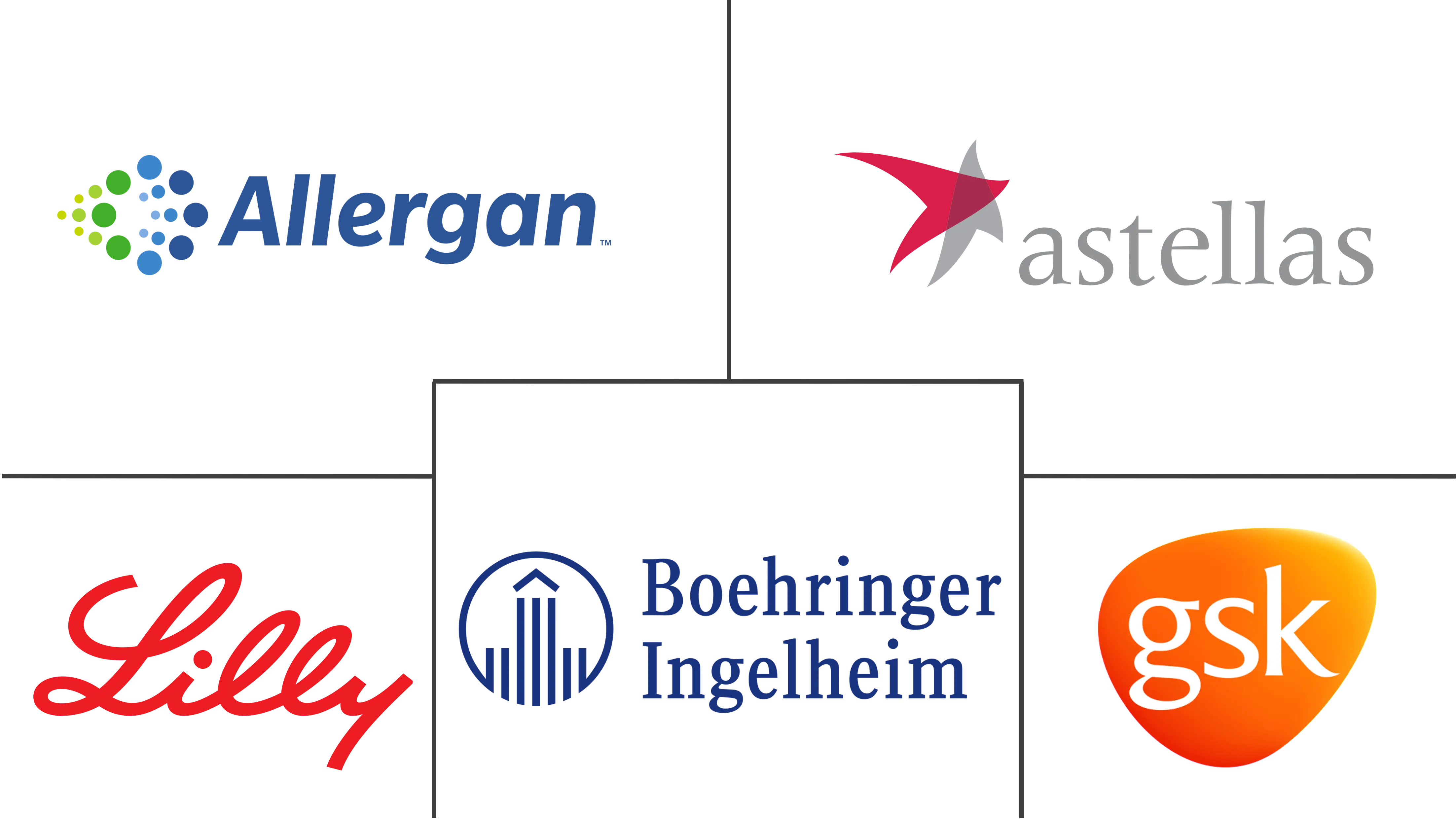Market Size of Benign Prostatic Hyperplasia Industry

| Study Period | 2019 - 2029 |
| Base Year For Estimation | 2023 |
| Forecast Data Period | 2024 - 2029 |
| CAGR | 8.50 % |
| Fastest Growing Market | Asia Pacific |
| Largest Market | North America |
Major Players
*Disclaimer: Major Players sorted in no particular order |
Benign Prostatic Hyperplasia Market Analysis
The benign prostatic hyperplasia market is expected to register a CAGR of nearly 8.5% during the forecast period (2022-2027). Benign prostatic hyperplasia (BPH) also known as benign prostatic hypertrophy is characterized by the unusual propagation of the prostatic cells, which causes difficulties, like urinary retention and infection of the urinary tract. It is most common among aging men.
According to the Union for International Cancer Control (UICC) in May 2020, there was a significant decrease in disease diagnostic rates in the United States during the COVID-19 pandemic. This had a significant impact on the market growth. However, such hindering impact on growth is anticipated to persist for a short duration. Moreover, according to the study titled 'Impact of the COVID-19 outbreak on prostate care in the Netherlands', published in the Cancer Treatment and Research Communications in January 2022, during the first COVID-19 wave, there was a 17% decrease in prostate cancer diagnoses. The reduction was most noticeable among the elderly and those with low-risk localized prostate conditions such as Benign Prostate Hyperplasia.
Benign prostatic hyperplasia (BPH) is being accepted as a growing health problem among elderly men. As per the 2022 data published by World Population Review, the average age of men is highest in Monaco i.e., 52 years as of 2022. The data suggests that the old men population is believed to increase rapidly over the coming years. With the rising population of aged men, the degree of the problem is projected to rise multifold over the next few years.
The geriatric population is expected to have a significant impact on the market studied as people aged above 65 are more prone to prostate cancer. According to the World Health Organization Facts of 2021, the proportion of the global population aged 60 and up will nearly double from 12% to 22% between 2015 and 2050. By 2050, 80% of the world's elderly will live in low and middle-income countries. The population is aging at a much faster rate than in the past. Every country faces significant challenges in ensuring that its health and social systems are prepared to take advantage of this demographic shift. According to the World Health Organization, in May 2020, by 2030, one out of every six people on the planet will be 60 years old or older. The number of people aged 60 and up is expected to rise from 1 billion in 2020 to 1.4 billion by 2050. By 2050, the global population of people aged 60 and above will double to reach 2.1 billion. Between 2020 and 2050, the number of people aged 80 and above is expected to triple, reaching 426 million. Benign prostate hyperplasia (BOH) is majorly associated with the age of a person and as the age increases, the chances of BPH increases. Hence, with a rise in geriatric population, the market studied is expected to witness strong growth in coming years.
Benign Prostatic Hyperplasia Industry Segmentation
As per the scope of the report, benign prostatic hyperplasia is a medical condition involving enlargement of the prostate gland and it is highly prevalent in males. It is a non-cancerous growth of the prostate gland originating from the uncontrolled expansion of prostate cells. The Benign Prostatic Hyperplasia Market is segmented by Drug Type (Alpha-Blockers, 5- Alpha-Reductase Inhibitors (5-Aris), Alpha-Adrenergic Blockers, Phosphodiesterase-5 Enzyme Inhibitors, and Other Drug Types), Distribution Channels (Hospital Pharmacies, Retail Pharmacies, Online Pharmacies), and Geography (North America, Europe, Asia-Pacific, Middle East, and Africa, and South America). The market report also covers the estimated market sizes and trends for 17 different countries across major regions, globally. The report offers the value (in USD million) for the above segments.
| By Drug Type | |
| Alpha-Blockers | |
| 5- Alpha-Reductase Inhibitors (5-Aris) | |
| Alpha-Adrenergic Blockers | |
| Phosphodiesterase-5 Enzyme Inhibitors | |
| Other Drug Types |
| By Distribution Channel | |
| Hospital Pharmacies | |
| Retail Pharmacies | |
| Online Pharmacies |
| Geography | ||||||||
| ||||||||
| ||||||||
| ||||||||
| ||||||||
|
Benign Prostatic Hyperplasia Market Size Summary
The benign prostatic hyperplasia (BPH) market is poised for substantial growth, driven by the increasing prevalence of this condition among the aging male population. BPH, characterized by the abnormal growth of prostatic cells, leads to urinary retention and infections, and is predominantly seen in older men. The market is experiencing a resurgence following the temporary setbacks caused by the COVID-19 pandemic, which had led to a decline in diagnostic rates. As the global population of elderly men continues to rise, the incidence of BPH is expected to increase, thereby expanding the market. The geriatric demographic, particularly those over 65, is a significant contributor to market growth, as they are more susceptible to prostate-related conditions. This demographic shift presents both challenges and opportunities for healthcare systems worldwide, necessitating advancements in treatment and management strategies.
The market is further bolstered by the development and availability of novel treatments, such as alpha-blockers and combination therapies like TADFIN, which are gaining traction as first-line treatments for BPH. These medications are crucial for alleviating symptoms and improving the quality of life for affected individuals. North America leads the market, attributed to the high prevalence of BPH and the robust healthcare infrastructure that supports research and development in this field. The United States, in particular, is witnessing a surge in demand for early diagnosis and treatment, driven by the rising incidence of prostate cancer. Key pharmaceutical players, including Allergan PLC, Eli Lilly & Company, and Boehringer Ingelheim, are actively engaged in strategic initiatives to enhance their market presence. Collaborations, mergers, and new product launches are pivotal in maintaining competitive advantage and addressing the growing needs of the BPH patient population.
Benign Prostatic Hyperplasia Market Size - Table of Contents
-
1. MARKET DYNAMICS
-
1.1 Market Overview
-
1.2 Market Drivers
-
1.2.1 Rising Geriatric Population
-
1.2.2 Growing Technological Advancements in Personalized Medicines
-
-
1.3 Market Restraints
-
1.3.1 Rising Preference Toward Minimally Invasive Surgeries
-
1.3.2 Non-adherence of Patients to Pharmacological Therapy
-
-
1.4 Porter's Five Force Analysis
-
1.4.1 Threat of New Entrants
-
1.4.2 Bargaining Power of Buyers/Consumers
-
1.4.3 Bargaining Power of Suppliers
-
1.4.4 Threat of Substitute Products
-
1.4.5 Intensity of Competitive Rivalry
-
-
-
2. MARKET SEGMENTATION
-
2.1 By Drug Type
-
2.1.1 Alpha-Blockers
-
2.1.2 5- Alpha-Reductase Inhibitors (5-Aris)
-
2.1.3 Alpha-Adrenergic Blockers
-
2.1.4 Phosphodiesterase-5 Enzyme Inhibitors
-
2.1.5 Other Drug Types
-
-
2.2 By Distribution Channel
-
2.2.1 Hospital Pharmacies
-
2.2.2 Retail Pharmacies
-
2.2.3 Online Pharmacies
-
-
2.3 Geography
-
2.3.1 North America
-
2.3.1.1 United States
-
2.3.1.2 Canada
-
2.3.1.3 Mexico
-
-
2.3.2 Europe
-
2.3.2.1 Germany
-
2.3.2.2 United Kingdom
-
2.3.2.3 France
-
2.3.2.4 Italy
-
2.3.2.5 Spain
-
2.3.2.6 Rest of Europe
-
-
2.3.3 Asia Pacific
-
2.3.3.1 China
-
2.3.3.2 Japan
-
2.3.3.3 India
-
2.3.3.4 Australia
-
2.3.3.5 South Korea
-
2.3.3.6 Rest of Asia-Pacific
-
-
2.3.4 Middle East and Africa
-
2.3.4.1 GCC
-
2.3.4.2 South Africa
-
2.3.4.3 Rest of Middle East and Africa
-
-
2.3.5 South America
-
2.3.5.1 Brazil
-
2.3.5.2 Argentina
-
2.3.5.3 Rest of South America
-
-
-
Benign Prostatic Hyperplasia Market Size FAQs
What is the current Benign Prostatic Hyperplasia Market size?
The Benign Prostatic Hyperplasia Market is projected to register a CAGR of 8.5% during the forecast period (2024-2029)
Who are the key players in Benign Prostatic Hyperplasia Market?
Allergan PLC, Eli Lilly and Company, Merck & Co., Inc., Boehringer Ingelheim and Astellas Pharma Inc. are the major companies operating in the Benign Prostatic Hyperplasia Market.

